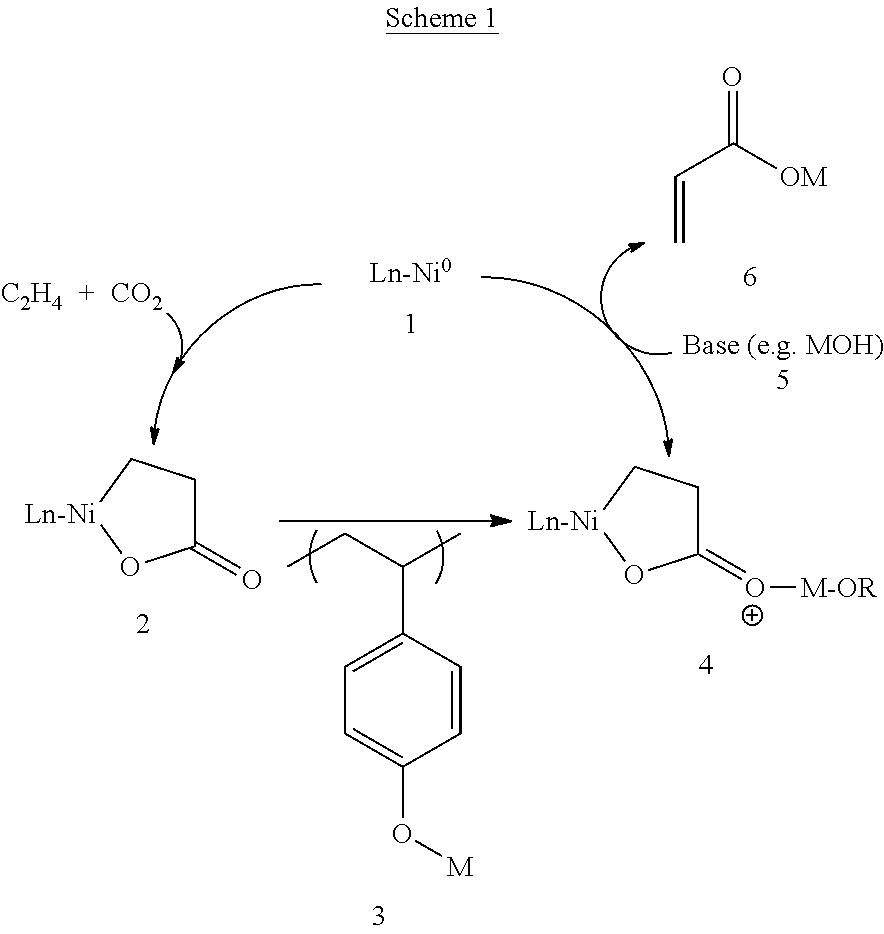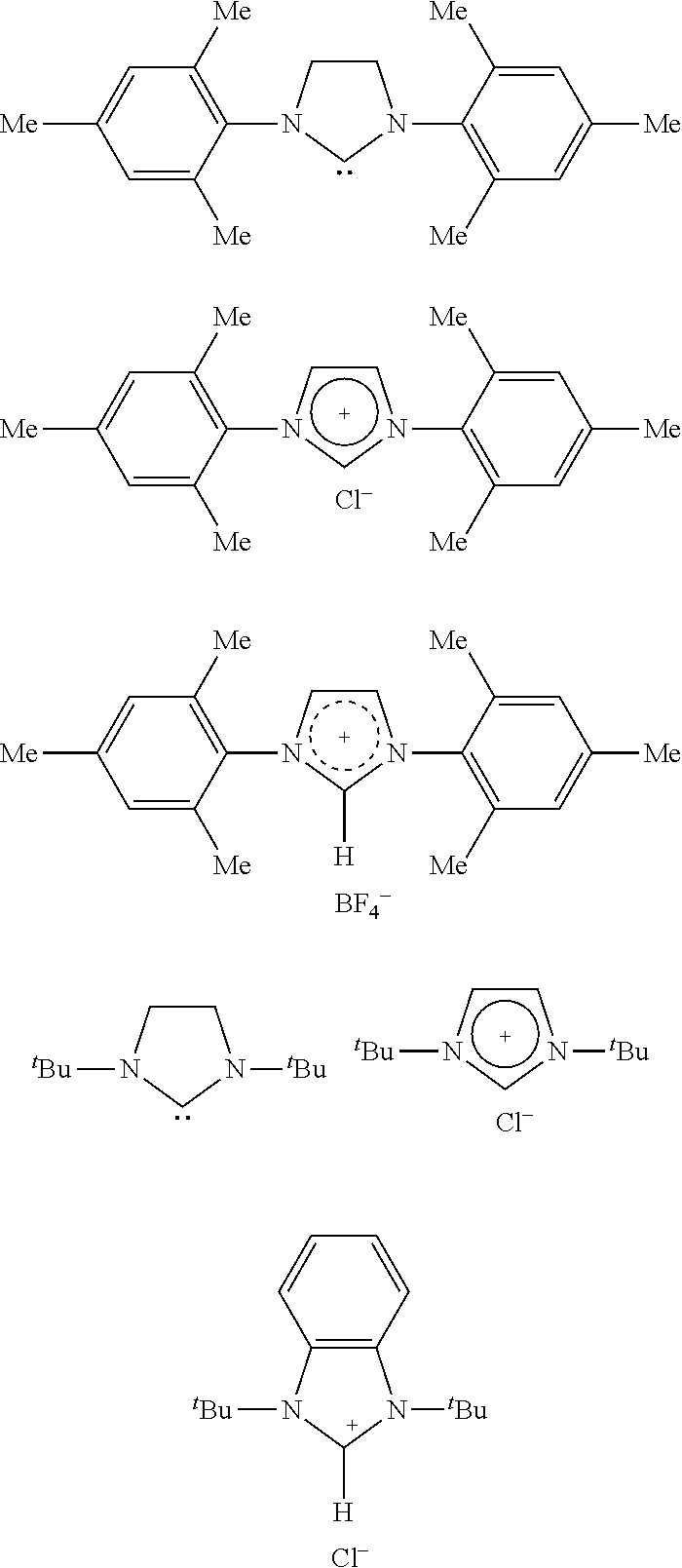Formation of alpha,beta-unsaturated carboxylic acids and salts thereof from metalalactones and anionic polyelectrolytes
a technology of alpha-beta-unsaturated carboxylic acid and anionic polyelectrolytes, which is applied in the preparation of carboxylic compounds, organic compounds/hydrides/coordination complexes, and physical/chemical process catalysts. it can solve the problems of difficult separation/isolation procedures, poor yield, and conventional methods that generally make the isolation of the desired ,-unsaturated carboxylic acid (e.g., acrylic acid) difficult, and achieve high yield
- Summary
- Abstract
- Description
- Claims
- Application Information
AI Technical Summary
Benefits of technology
Problems solved by technology
Method used
Image
Examples
examples
[0147]The invention is further illustrated by the following examples, which are not to be construed in any way as imposing limitations to the scope of this invention. Various other aspects, embodiments, modifications, and equivalents thereof which, after reading the description herein, can suggest themselves to one of ordinary skill in the art without departing from the spirit of the present invention or the scope of the appended claims.
General Considerations
[0148]Unless otherwise noted, all operations were performed under purified nitrogen or vacuum using standard Schlenk or glovebox techniques. Toluene (Honeywell) and tetrahydrofuran (Aldrich) was degassed and dried over activated 4 Å molecular sieves under nitrogen. Sodium tert-butoxide, potassium tert-butoxide, poly(4-vinylphenol) (Mw˜11,000 g / mol), poly(4-vinylphenol-co-methyl(meth)acrylate) (Mw˜8,000-12,000 g / mol), and brominated poly(4-vinylphenol) (Mw˜5,800 g / mol) were purchased from Sigma-Aldrich and used as received. Pheno...
examples 1-10
Experimental Procedure for Ethylene / Carbon Dioxide Coupling
[0154]The ethylene / carbon dioxide reaction of these examples is set out in reaction (1) below, and specific reagents, reaction conditions, and yields are set out in Table 1.
[0155]A 1-liter autoclave pressure reactor was charged with solvent followed by a combined mixture of Ni(COD)2 (0.10 mmol), bis(dicyclohexylphosphino)ethane (0.11 mmol), and poly(4-vinylphenoxide) (1.00 g) in 10 mL of solvent. The reactor was set to 50° C., pressurized with ethylene at the desired level, and equilibrated for 5-10 minutes (min) prior to being pressurized and equilibrated with carbon dioxide. The reactor was then set to 100° C. and stirred for 6 hours. After this reaction time, and after cooling to ambient temperature, the reactor was slowly vented and the mixture was collected. The solvent was removed in vacuo and the residue was stirred in 10-20 mL of deuterium oxide for 30 min prior to the addition of a sorbic acid / acetone-d6 solution. T...
examples 11-17
Experimental Procedure for Nickelalactone Conversion to Acrylate
[0156]To study the elimination step of the disclosed process, the efficiencies of various alkoxides or aryloxides for the conversion of a diphosphine-stabilized nickelalactone to acrylic acid were assessed. Specifically, the following experiments show the efficiencies of sodium and potassium (4-vinylphenoxide) for the conversion of an in situ prepared diphosphine-stabilized nickelalactone, and the data were compared to the conversion using molecular sodium tert-butoxide for acrylate formation from the analogous nickelalactones. The metalalactone to acrylate conversion reaction of these examples is set out in reaction (2) below, and specific reagents, reaction conditions, and yields are set out in Table 2. In reaction (2), the “metal alkoxide” includes the polymeric alkoxides shown in Table 2.
[0157]In a 10 mL vial, (TMEDA)Ni(CH2CH2CO2) (0.018 mmol), bis(dicyclohexylphosphino)-ethane (0.018 mmol), poly(4-vinylphenoxide), ...
PUM
| Property | Measurement | Unit |
|---|---|---|
| partial pressure | aaaaa | aaaaa |
| partial pressure | aaaaa | aaaaa |
| temperature | aaaaa | aaaaa |
Abstract
Description
Claims
Application Information
 Login to View More
Login to View More - R&D
- Intellectual Property
- Life Sciences
- Materials
- Tech Scout
- Unparalleled Data Quality
- Higher Quality Content
- 60% Fewer Hallucinations
Browse by: Latest US Patents, China's latest patents, Technical Efficacy Thesaurus, Application Domain, Technology Topic, Popular Technical Reports.
© 2025 PatSnap. All rights reserved.Legal|Privacy policy|Modern Slavery Act Transparency Statement|Sitemap|About US| Contact US: help@patsnap.com



